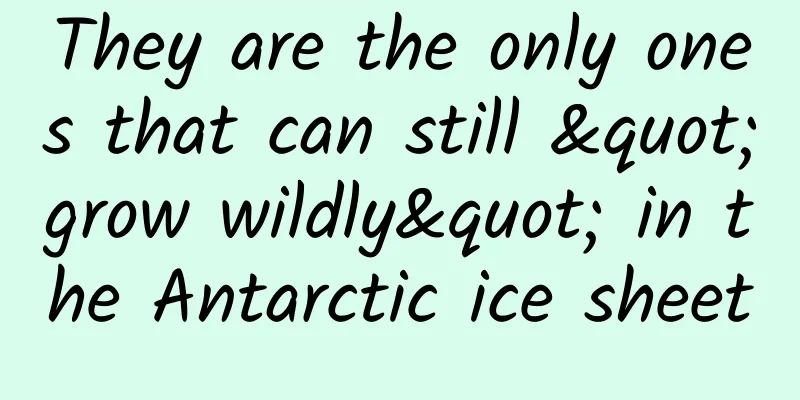They are the only ones that can still "grow wildly" in the Antarctic ice sheet

|
Produced by: Science Popularization China Author: Life Pulse Team Producer: China Science Expo When you think of Antarctica, do you naturally think of a land of ice and snow? This is indeed the case. Antarctica covers an area of 14 million square kilometers, and most of its area is covered with ice and snow all year round. Therefore, Antarctica is also called the "Antarctic Ice Sheet" or the "White Desert". Antarctica (Photo source: Veer Gallery) Even in the short months of summer, only 5% of Antarctica has exposed bedrock without ice or snow. These exposed bedrock are called ice-free areas or "white desert" oases. These oases are mainly distributed on the edge of the Antarctic continent and on the islands around the continent. The "white desert" oases are the main habitats for Antarctic terrestrial and freshwater organisms. It is these organisms that bring vitality to this bleak and indifferent continent. Weddell Sea, Antarctica (Photo source: Veer Gallery) Antarctica - the land with the least vegetation on Earth Antarctica is isolated from other continents of the world. At the same time, factors such as the extremely cold, dry, windy, low sunshine, nutrient deficiency and short growing season severely restrict the growth of terrestrial plants in Antarctica. Therefore, there are few plants, no trees and flowers, and very few higher plants. In contrast, the plants in the Arctic are much more luxuriant and diverse than those in Antarctica. Although the Arctic is also cold and windy, with changeable climate, winter temperatures are often below -60°C, and most areas are permafrost, it is not as cold as Antarctica after all. Therefore, the Arctic has more than 100 species of flowering plants, more than 2,000 species of lichens, more than 500 species of mosses, and plants that are not found in Antarctica, such as gymnosperms. At present, scientists have discovered more than 850 species of plants in Antarctica, most of which are lower plants, and only three flowering plants belong to higher plants. Among the lower plants, there are more than 350 species of lichens, more than 370 species of mosses, and more than 130 species of algae. Therefore, Antarctica is the land with the fewest plants on Earth. However, it is these plants that together paint a unique ecological "picture" on the Antarctic ice sheet. Rare Plants in Antarctica: Flowering Plants Flowering plants are only distributed on the northern tip of the Antarctic Peninsula and the oceanic islands around the Antarctic continent. The southern limit of flowering plants on Earth is about 64 degrees south latitude, and the northern tip of the Antarctic Peninsula and some islands just cross the "flowering plant line". The three flowering plants that grow in Antarctica are all herbaceous. One is a cushion grass, and the other two are hair grass plants, which are similar in shape to grass plants, with narrow and long leaves, parallel veins, nodes, internodes and stalks, and spikelet inflorescences. They have a certain ability to adapt to the Antarctic environment, have a long life cycle and flowering period, are perennial, and increase biomass and accumulate energy through a large number of stalks. Antarctic hairgrass, one of the native flowering plants of Antarctica (Photo source: Veer Gallery) Antarctica's widespread indigenous species: lichens Lichen is one of the oldest plants on Earth and a primitive type of lower plant. Because it can adapt to the desert-like dryness and extremely cold environment of Antarctica, it is the most widely distributed and most diverse native Antarctic plant. Orange lichen on icy rocks (Photo source: Veer Gallery) It is mainly distributed in the oases of the Antarctic continent and the rock surfaces that are sometimes covered with ice and snow. There are also traces of it on rocks that are only a few degrees away from the South Pole. Interestingly, lichens are plants that complete their life cycle in the season with sunlight. Lichens reproduce by spores and grow very slowly. Even the largest and fastest growing species only grow one millimeter every hundred years. It is said that a ten-centimeter-tall lichen has a lifespan of about 10,000 years. Some people may ask, how do lichens get nutrition when they grow on the ice and snow of Antarctica? In fact, the water needed for lichens to grow comes from melted ice and snow, and the nutrients they need are provided by chemical weathering products of rocks. This may be because the wind brings bird droppings from far away, like wind-blown dust, to the place where lichens grow. Existing research shows that the rhizomes of some species of lichens can secrete lichen acid to dissolve rocks, which not only fixes themselves, but also obtains nutrition from them. There are more than 350 species of lichens in Antarctica, ranging in size from 10 to 15 centimeters to just a few millimeters. Some species grow on the surface of rocks, forming "spots" of different shapes and colors. Rocks and lichen on the beach (Photo source: Veer Gallery) Plants that feed on guano: mosses Mosses require more water to grow than lichens. Therefore, there are fewer species of mosses and their distribution range is not as wide as that of lichens. In relatively warm coastal areas, where melting ice and snow can provide abundant water, there are large areas of moss growth, such as Wilkes Land in East Antarctica and the west coast of the Antarctic Peninsula. Mosses are more widely distributed on islands around the Antarctic continent, and their nutrition mainly comes from bird droppings and rock weathering. moss (Photo source: Veer Gallery) Plants that “take advantage of every opportunity”: Algae In terms of biomass, algae are the most abundant plants in Antarctica. They are widely distributed on the terrestrial ground, rock surfaces, crevices, ice and snow, and temporary streams and ponds formed when ice and snow melt in oases. Bright green single-celled algae grow on the surface of rocks, blue-green algae grow in land ice, and red algae growing in the snow can dye the white snow into a rose color, which is very beautiful. Wrinkled stream mosses often grow in streams where ice and snow melt. The stream water flowing through the penguin habitat contains rich nitrogen and phosphorus nutrients, so the growth of algae is even more luxuriant. Red algae blooms on the Antarctic Peninsula during brief summer (Photo source: Veer Gallery) Penguins standing on colorful ice (Photo source: Veer Gallery) Conclusion As the land with the fewest plants in the world, Antarctica has always given people the impression of an endless world of ice and snow. However, surprisingly, on this frozen land, there are still some plants that are "growing wildly" in the cold wind. On the one hand, they absorb the nourishment of glacial snow water, and on the other hand, they use their lives to add a little color to this white "canvas". Editor: Ying Yike |
<<: Comics | A guide to scientific melon-eating
>>: Latest research! Not everyone needs eight glasses of water a day
Recommend
Apple CEO Cook rarely reveals his smart home private life throughout the day
Tencent Technology News: Smart home and the Inter...
The answers to these questions that were not explained in "The First Lesson of School" are here
The First Lesson of School is also a science less...
User operation: How to do user segmentation?
We have said that user stratification is a specia...
[Website weight] Summary of methods to improve website weight to teach you how to effectively improve weight
1. What is website weight? Website weight refers ...
Editor-in-Chief Liu's 21-lesson writing practice training camp is worth 2,299 yuan
Understanding market demand with Editor-in-Chief ...
No wonder I don’t like carrots, they are from the same family as coriander!
Audit expert: Shi Jun Doctor of Botany, well-know...
Form costs reduced by 30%, home decoration advertising case!
With the further deepening of regulation and cont...
Meizu MX5 hands-on experience with full metal body
Meizu, which releases new phones at a rapid pace,...
The pitfalls I encountered in community operation: It turns out that meeting the high-frequency needs of users is the root of activity!
Community operation has been a hot topic and is b...
It's time to clarify these six misunderstandings! Unveiling the mystery of psychiatric wards
According to the World Mental Health Report relea...
The king of comfort, lightness and no burden, Sony LinkBuds is both "sweet" and novel!
As a world-class audio equipment manufacturer, So...
The magic weapon that strengthens plastics may be an "invisible assassin" of health!
Audit expert: Zhou Hongzhi Senior Experimentalist...
2015 Chinese Programmers Survival Report—How miserable life is!
Coding at work, coding overtime, and falling asle...
Revelation on user growth in 2020!
At a time when traffic is becoming increasingly s...
Keep the moral bottom line: 15 kinds of "rogue" methods of APP promotion
Rogue promotion methods are methods that some man...









